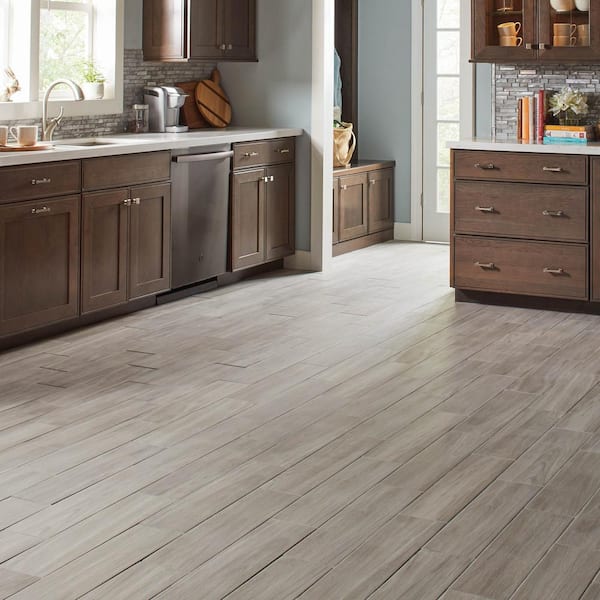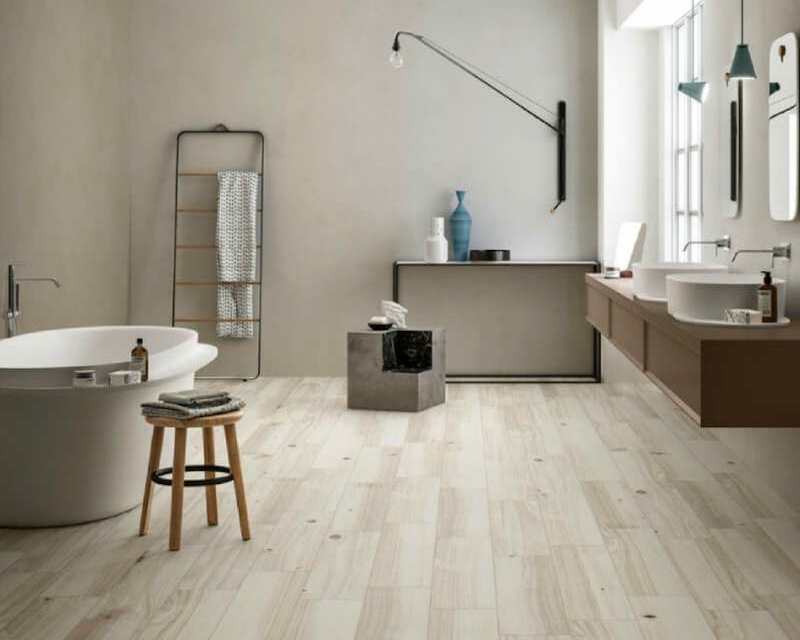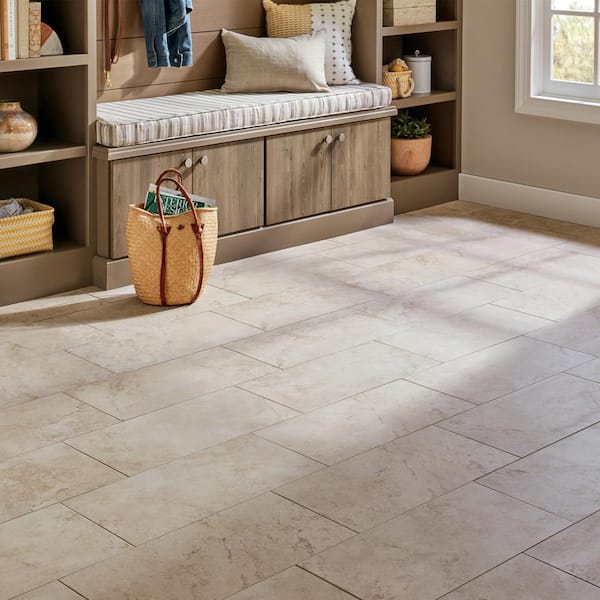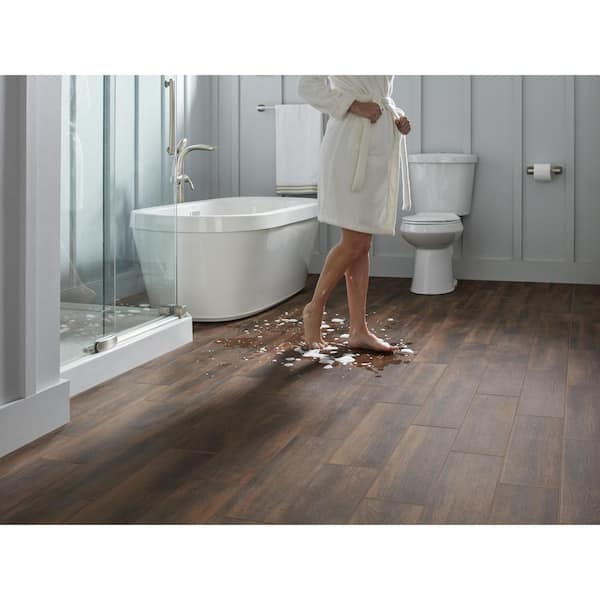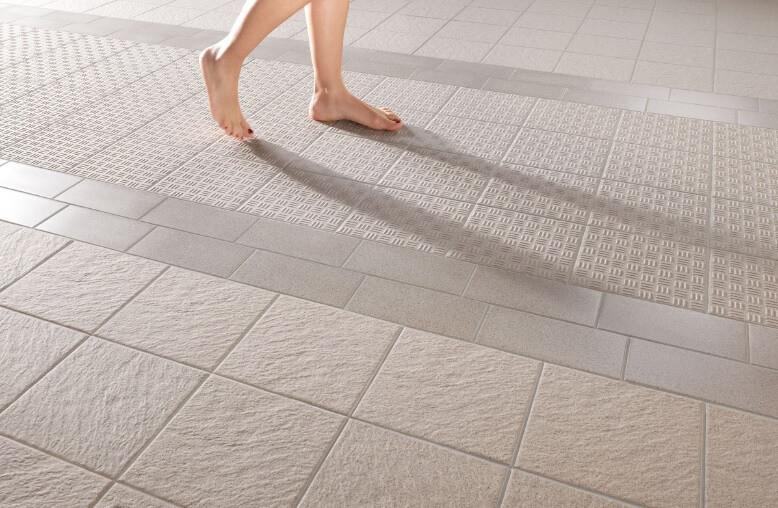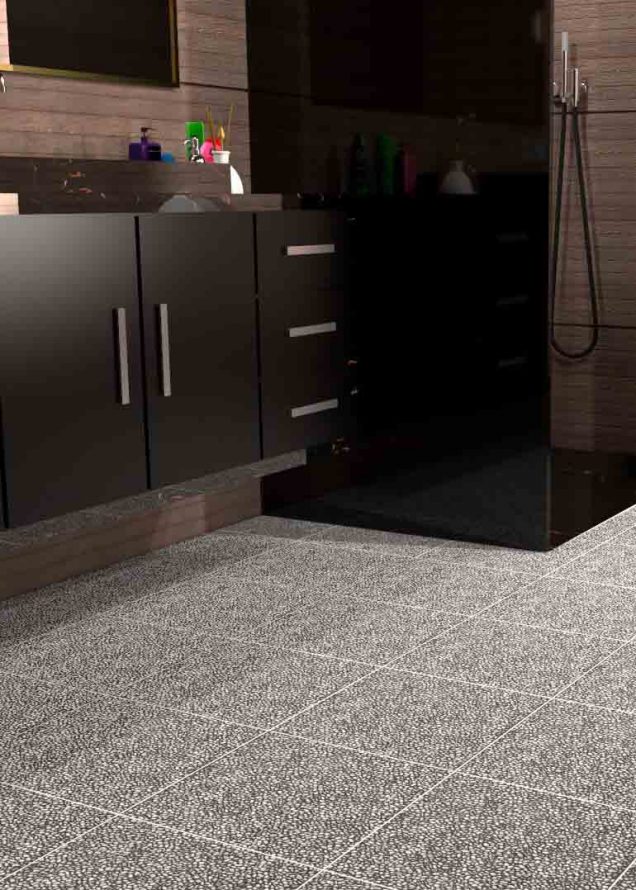The Importance of Slip Resistance in Porcelain Tile Flooring
Slip resistance is a crucial factor to consider when choosing flooring materials, especially for areas prone to moisture or spills. Porcelain tile flooring, known for its durability and versatility, offers various options for slip resistance to enhance safety in homes and commercial spaces. Understanding the importance of slip resistance in porcelain tile flooring is essential for creating a safe and secure environment. Let’s find out why slip resistance matters in porcelain tile flooring.
- Preventing Accidents: Slip and fall accidents can lead to serious injuries, especially in high-traffic areas such as kitchens, bathrooms, and entryways. Porcelain tile flooring with slip-resistant properties helps reduce the risk of accidents by providing better traction and grip underfoot, even when wet or slippery. This is particularly beneficial for households with children, elderly individuals, or individuals with mobility issues.
- Enhancing Safety in Wet Areas: Areas prone to moisture, such as bathrooms, laundry rooms, and pool decks, require flooring materials that offer reliable slip resistance. Porcelain tile flooring with slip-resistant surfaces provides added safety in wet environments by minimizing the risk of slips and falls. Whether it’s splashes from the shower or water tracked in from the pool, slip-resistant porcelain tile flooring helps maintain traction and stability underfoot.
- Compliance with Safety Standards: In commercial settings, adherence to safety standards and regulations is paramount to ensure the well-being of employees, customers, and visitors. Slip-resistant porcelain tile flooring helps businesses meet safety requirements by providing surfaces that meet or exceed industry standards for slip resistance. By choosing flooring materials that prioritize safety, businesses can minimize liability risks and create safer environments for everyone.
- Peace of Mind: For homeowners, investing in slip-resistant porcelain tile flooring offers peace of mind knowing that their loved ones and guests are less likely to experience accidents or injuries due to slippery surfaces. Whether it’s a busy household bustling with activity or hosting gatherings with friends and family, slip-resistant flooring provides added reassurance and confidence in the safety of the home environment.
- Long-Term Durability: Slip-resistant porcelain tile flooring not only enhances safety but also offers long-term durability and performance. With proper installation and maintenance, slip-resistant tiles can withstand heavy foot traffic, spills, and everyday wear and tear without compromising their slip-resistant properties. This ensures that the flooring retains its safety benefits and aesthetic appeal for years to come, making it a wise investment for any home or commercial space.

The Benefits of Slip-Resistant Porcelain Tile Flooring for Safety
Slip-resistant porcelain tile flooring offers a wide range of benefits for safety, making it an ideal choice for homes, businesses, and public spaces. With its durable construction and textured surfaces, slip-resistant porcelain tile flooring provides traction and stability underfoot, reducing the risk of slips and falls. Below are various benefits of slip-resistant porcelain tile flooring for safety.
Enhanced Traction: The primary benefit of slip-resistant porcelain tile flooring is its ability to provide enhanced traction and grip underfoot. Textured surfaces, embossed patterns, or specialized coatings create friction between the tile and footwear, reducing the likelihood of slips and falls, even in wet or slippery conditions. This added traction is particularly important in areas prone to moisture or spills, such as bathrooms, kitchens, and entryways.
Reduced Risk of Accidents: Slip and fall accidents can result in serious injuries, especially for children, the elderly, or individuals with mobility issues. Slip-resistant porcelain tile flooring helps minimize the risk of accidents by providing a stable and secure walking surface, even in high-traffic areas. By reducing the likelihood of slips and falls, slip-resistant flooring enhances safety and prevents potential injuries in homes, businesses, and public spaces.
Suitability for Wet Areas: Wet environments, such as bathrooms, showers, and swimming pool decks, pose unique safety challenges due to moisture accumulation and slippery surfaces. Slip-resistant porcelain tile flooring is specifically designed to withstand wet conditions and maintain traction underfoot, making it an ideal choice for these areas. Whether it’s preventing slips in the shower or providing stability around the pool, slip-resistant flooring enhances safety in wet environments.
Compliance with Safety Standards: In commercial settings, adherence to safety standards and regulations is essential to protect employees, customers, and visitors from accidents and injuries. Slip-resistant porcelain tile flooring helps businesses meet safety requirements by providing surfaces that meet or exceed industry standards for slip resistance. By choosing flooring materials that prioritize safety, businesses can create safer environments and minimize liability risks.
Versatility and Durability: Slip-resistant porcelain tile flooring offers versatility and durability, making it suitable for a wide range of applications and environments. Whether it’s residential kitchens, commercial bathrooms, or outdoor patios, slip-resistant tiles provide reliable traction and stability in various settings. With their long-lasting durability and resistance to wear and tear, slip-resistant porcelain tile flooring offers lasting safety benefits for both residential and commercial spaces, ensuring peace of mind and confidence in the safety of the environment.
Ease of Maintenance: In addition to enhancing safety, slip-resistant porcelain tile flooring is easy to maintain, further contributing to its appeal for homeowners and businesses. Regular sweeping, vacuuming, and mopping with a mild detergent keep the tiles clean and free of dirt, debris, and potential slip hazards. Unlike other flooring materials that may require special cleaning products or treatments, slip-resistant porcelain tile flooring offers straightforward maintenance routines for added convenience.
Long-Term Cost Savings: Investing in slip-resistant porcelain tile flooring can lead to long-term cost savings by reducing the risk of slip and fall accidents and their associated expenses. By minimizing accidents and injuries, homeowners and businesses can avoid potential medical bills, insurance claims, legal fees, and other liabilities. Additionally, the durability and longevity of slip-resistant porcelain tile flooring mean fewer replacements and repairs over time, further reducing maintenance costs and preserving the integrity of the flooring investment.
Enhanced Aesthetic Appeal: Beyond its safety benefits, slip-resistant porcelain tile flooring offers aesthetic appeal and design versatility, allowing homeowners and designers to create beautiful and functional spaces. Available in a wide range of colors, patterns, textures, and finishes, slip-resistant tiles complement various decor styles and architectural themes, from contemporary and modern to rustic and traditional. Whether it’s replicating the look of natural stone, wood, or concrete, slip-resistant porcelain tile flooring adds visual interest and sophistication to any room or environment.
Incorporating Slip Resistant Porcelain Tile Flooring into Your Home
Slip-resistant porcelain tile flooring offers not only safety benefits but also design versatility, making it an attractive option for homeowners looking to enhance the aesthetic appeal of their interiors. With a wide range of styles, colors, and textures available, slip-resistant porcelain tile flooring can complement any decor scheme while providing reliable traction and stability underfoot. Let’s see how you can incorporate slip-resistant porcelain tile flooring into your home to create beautiful and functional spaces.
Natural Stone Look: For homeowners who love the look of natural stone but prefer the durability and ease of maintenance of porcelain tile, slip-resistant tiles offer an excellent alternative. Choose slip-resistant porcelain tiles that mimic the appearance of natural stone, such as travertine, slate, or marble, to add timeless elegance and sophistication to your home. Whether it’s a rustic farmhouse kitchen or a luxurious spa-inspired bathroom, natural stone-look tiles create a stunning focal point while providing reliable slip resistance.
Wood-Look Flooring: Wood-look porcelain tile flooring has become increasingly popular in recent years, offering the warmth and beauty of hardwood with the durability and moisture resistance of porcelain. Slip-resistant wood-look tiles are ideal for areas prone to moisture or spills, such as kitchens, bathrooms, and entryways, where traditional hardwood flooring may not be suitable. Choose from a variety of wood species, finishes, and plank sizes to achieve the desired look, whether it’s rustic reclaimed wood or sleek contemporary hardwood.
Contemporary Patterns: Slip-resistant porcelain tile flooring comes in a variety of patterns and designs to suit modern and contemporary interiors. Opt for geometric patterns, hexagonal tiles, or subway tiles to add visual interest and dimension to your floors. Mix and match different colors and textures to create custom patterns and designs that reflect your style and taste. Whether it’s a bold statement floor in the entryway or a striking accent wall in the bathroom, contemporary patterned tiles offer endless design possibilities.
Neutral Color Palette: Neutral-colored slip-resistant porcelain tile flooring provides a versatile and timeless backdrop for any decor style, allowing furniture, accessories, and accents to take center stage. Choose shades of white, beige, gray, or taupe for a clean and cohesive look that complements a wide range of color palettes and design schemes. Neutral-colored tiles create a sense of openness and serenity in any room while offering the safety benefits of slip resistance.
Textured Finishes: In addition to their slip-resistant properties, porcelain tiles with textured finishes add tactile interest and depth to your floors, creating a sense of movement and dimension. Choose tiles with raised patterns, embossed designs, or textured surfaces to add visual intrigue and personality to your floors. Textured finishes are particularly beneficial in high-traffic areas where slip resistance is essential, providing both safety and style in one versatile flooring solution.
Seamless Transitions: Incorporating slip-resistant porcelain tile flooring allows for seamless transitions between indoor and outdoor spaces, blurring the boundaries between the two and creating a cohesive flow throughout your home. Choose slip-resistant tiles that are suitable for both interior and exterior use, such as porcelain pavers or outdoor-rated tiles, to create a unified look that extends from the entryway to the patio or deck. By seamlessly integrating indoor and outdoor flooring, you can enhance the functionality and aesthetics of your home while maximizing its living space.
Installation and Maintenance Tips
Proper installation and maintenance are essential for ensuring the longevity, performance, and safety of slip-resistant porcelain tile flooring. From preparing the subfloor to cleaning and upkeep, following best practices can help you achieve beautiful and functional floors that provide reliable traction and stability underfoot. Here are some essential tips for installing and maintaining slip-resistant porcelain tile flooring in your home.
Subfloor Preparation: Proper preparation of the subfloor is crucial for ensuring a successful tile installation. Before laying slip-resistant porcelain tiles, ensure that the subfloor is clean, flat, and free of any debris, dust, or contaminants. Repair any cracks, uneven areas, or imperfections in the subfloor to create a smooth and stable surface for the tiles. Additionally, verify that the subfloor meets industry standards and manufacturer recommendations for tile installation.
Choosing the Right Adhesive: Selecting the appropriate adhesive is essential for securely bonding slip-resistant porcelain tiles to the subfloor. Choose a high-quality, flexible thin-set mortar or adhesive that is specifically designed for use with porcelain tiles. Follow the manufacturer’s instructions and recommendations for mixing, applying, and curing the adhesive to ensure optimal adhesion and performance.
Proper Tile Layout: Plan the layout of the slip-resistant porcelain tiles carefully to ensure a visually appealing and functional installation. Consider factors such as the size and shape of the room, the location of fixtures and fittings, and the direction of natural light when determining the tile layout. Dry-lay the tiles beforehand to visualize the design and make any necessary adjustments before permanently setting the tiles in place.
Grout Selection and Application: Choosing the right grout is essential for completing the tile installation and ensuring a durable and aesthetically pleasing finish. Select a grout specifically formulated for use with porcelain tiles and designed to accommodate the size and spacing of the grout joints. Consider using stain-resistant or epoxy grout for added durability and ease of maintenance, especially in high-traffic or moisture-prone areas. Follow the manufacturer’s instructions for mixing, applying, and cleaning the grout to achieve optimal results and minimize the risk of staining or discoloration.
Comparing Slip Resistant Porcelain Tile Flooring to Other Flooring Options
When selecting flooring materials for your home or business, it’s essential to consider various options and their unique features and benefits. Slip-resistant porcelain tile flooring offers numerous advantages for safety, durability, and design versatility, making it a popular choice for a wide range of applications. Let’s compare slip-resistant porcelain tile flooring to other flooring options to help you make an informed decision for your next flooring project.
Slip Resistance:
- Slip-resistant porcelain tile flooring: Porcelain tiles are inherently slip-resistant, thanks to their textured surfaces and specialized finishes that provide better traction and grip underfoot, even in wet or slippery conditions. This makes them an ideal choice for areas prone to moisture or spills, such as bathrooms, kitchens, and entryways.
- Vinyl flooring: While some vinyl flooring options may offer slip resistance, not all vinyl products are created equal. Textured or embossed vinyl tiles or planks may provide better traction, but their slip resistance can vary depending on the specific product and installation method.
- Laminate flooring: Laminate flooring typically offers less slip resistance than porcelain tile, as it has a smoother surface that may become slippery when wet. While some laminate products feature textured finishes for added traction, they may not offer the same level of slip resistance as porcelain tile.
Durability:
- Slip-resistant porcelain tile flooring: Porcelain tiles are known for their exceptional durability and resistance to wear, scratches, and stains, making them suitable for high-traffic areas in both residential and commercial settings. With proper installation and maintenance, slip-resistant porcelain tile flooring can withstand years of use without losing its slip-resistant properties or aesthetic appeal.
- Vinyl flooring: Vinyl flooring is relatively durable and resistant to scratches, stains, and moisture, making it a popular choice for areas with high foot traffic or exposure to water. However, vinyl may be susceptible to damage from sharp objects or heavy furniture, and its wear layer can wear down over time, potentially compromising its slip resistance and longevity.
- Laminate flooring: Laminate flooring is known for its durability and scratch resistance, thanks to its tough wear layer and high-density fiberboard core. However, laminate may be less resistant to moisture and water damage than porcelain tile, and its slip resistance can vary depending on the texture and finish of the surface.
Design Options:
- Slip-resistant porcelain tile flooring: Porcelain tiles offer endless design possibilities, with a wide range of colors, patterns, textures, and finishes to choose from. Whether you prefer the look of natural stone, wood, concrete, or contemporary designs, slip-resistant porcelain tile flooring allows you to achieve your desired aesthetic while prioritizing safety.
- Vinyl flooring: Vinyl flooring comes in a variety of styles, including wood-look planks, stone-look tiles, and contemporary patterns. While vinyl may offer more design options than porcelain tile in terms of aesthetics and visual effects, it may not provide the same level of authenticity or durability as natural materials.
- Laminate flooring: Laminate flooring often replicates the look of hardwood or stone with photographic images and embossed textures. While laminate can offer a wide range of design options at a lower cost than natural materials, it may not provide the same level of durability or authenticity as porcelain tile.
Glazeguard Plus Anti Slip Floor Coating For Ceramic And Porcelain Tile
LIFEPROOF LifeProof Slip Resistant Porcelain Tile – The Home Depot
How to Choose the Right Anti-Slip Tiles from AGROB BUCHTAL
Slip-Resistant Commercial Flooring – Flooring Masters u0026 Pro Remodeling
Skid Resistance Scales for Tile Flooring
Slip Resistant Tile Floor
Mix Aran Stone Anti-Slip Porcelain Tile Floor and Decor
Related Posts:
